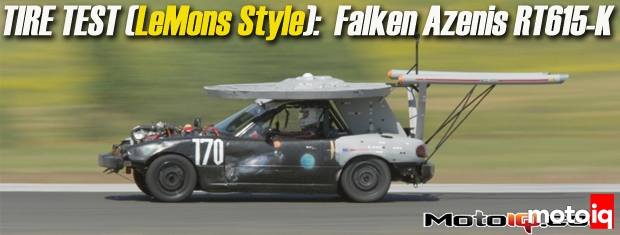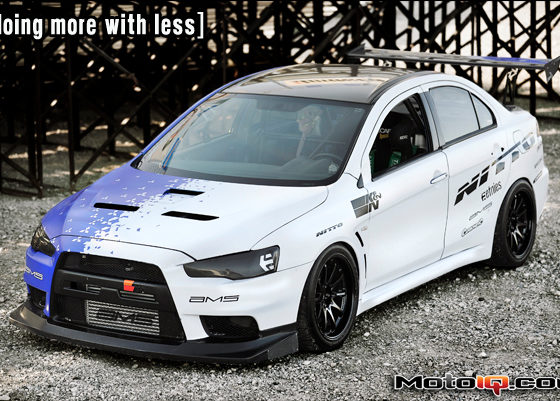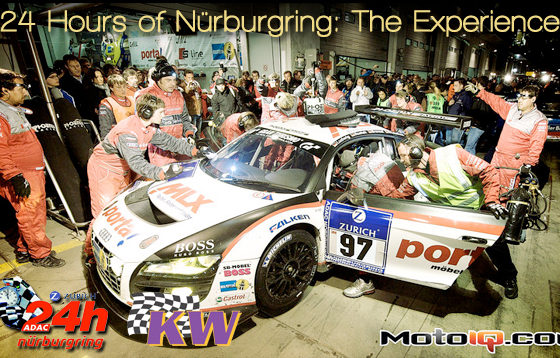
The typical new tire introduction goes like this: The new Pazoosy Jaberwoky XR 745 Ultra R Super Star uses triple-inverted diagonal ply Inconel belts and a directional, asymmetrical tread pattern to optimize wet and dry grip, minimize road noise, increase your fuel economy and magnify your sex appeal. The sad truth is that neither the author, nor the PR team that fed him that line of technospew has any idea what triple-inverted diagonal ply Inconel belts are or what they do.
 | |
| Obligatory tire shot. Looks just like the old one… |
That's what makes this tire review great. I have no idea what Falken did to change this tire. The new Azenis RT615-K is just as round and black as the Azenis RT615 it replaces. In fact, the tread pattern is the same, most of the sizes are the same, and really the only visual distinction is the little “K” on the sidewall.
I do know that I'm a fan of the old Falken Azenis RT615. It wasn't the grippiest tire on the market, and it wasn't the cheapest, but it seemed to occupy a happy balance of cheap enough and sticky enough to be on your daily driver, your track car, or your car that happens to be both. I've pulled 1.0g with Project Silvia on these tires, I've done 1500 mile road trips on these tires, and I've endurance raced on them.
We've been running the 615s on our LeMon for 11 very successful races, capturing 4 outright victories and more top 5 finishes than we can be bothered to keep track of. Even at that pace, our tiny 195/60-14s easily last through the 14 or so hours that make up almost every 24 Hours of LeMons and still have enough life left that the ones that aren't hopelessly flat spotted still have at least a track day's worth of hoonassery left in them.
At this year's Going For Broken race at Thunderhill we stumbled into a unique tire testing opportunity. We had 6 used, but still very serivceable RT615s in remarkably good shape after running a full 14 hours at Infenion Raceway and winning the Sears Pointless race. We also had 4 new RT615-Ks. Same car, same track, and over 2 hours of racing on each to sort out the differences.
 |
| Yea, you can feel it up there… |
So, finally, what's the difference? About 3 seconds (or 2, if you want to assume our old tires were 1 second off their peak), knocking our fastest lap of Thunderhill (counterclockwise, full track, without the turn-5 bypass) from a 2:16:somethingorother to a 2:13:andalittlebit.
The RT-615-K has more raw grip than the old RT-615, but more importantly, its much easier to drive. The limit behavior is more forgiving, with smoother breakaway and more grip at high slip angles that makes them easier to control at the limit and beyond. This breakaway character manifestes itself in some unexpected ways.
The damping from our tired old stock Miata shocks actually felt better with the new tires. Softer sidewalls? I don't think so. The sudden breakaway of the old tires, coupled with the extra weight of an 80-lb starship on the roof of our car, caused some sudden roll inputs into the chassis on turns 14 and 15 (a tight, 180-degree combination with several curbs and rumble strips) that would send the car into the bump stops and set up a very unprofessional bouncing, porpoising corner exit. With the 615-K, the smoother limit behavior meant breakaway and recovery weren't violent enough to over-work the suspension. The result was smoother car that suddenly felt like the shocks weren't 17 year old.
 | |
| There's nothing like a menacing Volvo all up in your dilithium crystals to make your push a little harder… |
In short, the new Azenis RT-615-K costs a few bucks more than the old RT-615. Its worth it.
From the Starship: (turn down the volume)



